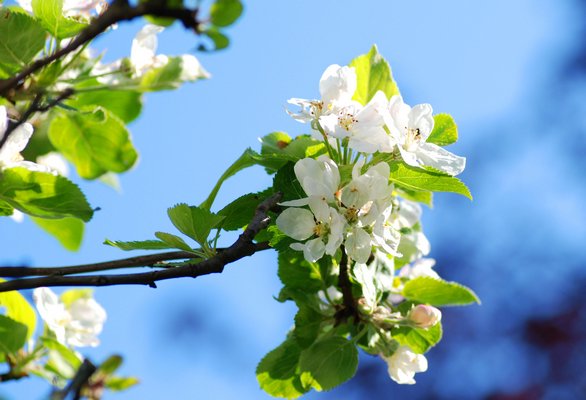

Aren’t you glad you heeded my advice back in December about winter mulches and protecting your marginal or sensitive plants for the winter months?The temperatures of the past few weeks haven’t been felt out here for at least a quarter of a century. I’m sure we’re going to see the effects of the freeze beginning in spring and running through the growing season.
For those of you who have decided to push the hardiness envelope, thinking that global warming was a sudden and pervasive change in our climate, think again. I don’t doubt that global warming is taking place. I just think it’s much more subtle than some have led us to believe. The days of hardy banana plants and hardy palms growing in the Hamptons are decades to centuries away.
But, if you’ve got cabin fever and need to get a jump on spring, the branches from flowering trees and shrubs can be forced into bloom easily and inexpensively indoors. Flowering branches can bring the outdoors inside and add color during the long and very cold winter.
These branches also give the floral designer or even a dabbler some unique and inexpensive alternatives for indoor color and fragrance. If you’ve never done this before you’ve got little to lose, and there’s nothing quite like the scent and sight of apple blossoms in bloom on a cold and dreary March day.
Trees and shrubs which bloom early in the spring form flower buds the previous fall before dormancy. Each variety needs a minimum number of chilling hours to produce viable flowers. But, for our purposes after at least eight weeks of cold weather (that’s under 40 degrees so any time after mid- to late January on the East End), the branches are ready to overcome dormancy and are capable of blooming.
By undergoing spring-like temperatures indoors with ample moisture, the flowers are forced open. Successful forcing depends on the type of plant, cultivar, stage of dormancy and temperature.
What follows are some guidelines for successful forcing though everyone’s experience will vary slightly. To ensure good results and to be sure that branches have fulfilled their dormancy requirements, it is best to wait until mid-January to begin forcing branches.
Carefully prune out branches, taking care not to injure the plant or ruin the shape or rob the bulk of spring buds from the parent plant. Select branches that are well-budded, i.e. with a large number of flower buds. Best results will occur with younger branches because they have more flower buds.
Flower buds are usually larger and rounder than leaf buds. If there is a question, cut a few buds open with a knife or single-edged razor blade and look for the flower parts.
Some fruit trees bear flowers on short fruit spurs. Watch for these on apples, pears and ornamental crab apples.
And don’t limit yourself to fruit trees, either. There are the standards like forsythia and pussy willows but you can also force azaleas, magnolias, dogwoods and rhododendrons.
In all, there are more than 30 different trees and shrubs that can be forced to produce their flowers or catkins, some for scent and others for shape, form and color. You can find a fairly comprehensive list of forcible branches and the time it takes to get them to bloom online at the Purdue University Cooperative Extension Service website at hort.purdue.edu/ext/ho-23.pdf.
Select branches at least 12 inches long, and prune them flush with the trunk or main branch. On shrubs such as forsythias and pussy willows, the branches can be several feet long but look for the branches that have the highest bud count per foot.
By pruning flush, the wound will heal over quickly and with little danger of insect- or disease damage. Be sure to use sharp pruning shears to minimize damage.
Once the branches have been cut, bring them indoors and place the stem ends in water immediately. If possible, totally submerge the branches in room temperature water overnight. A washtub or bathtub works well for this. This soaking allows the branches and buds to begin to break dormancy and rehydrate. Following this, place the branches in a bucket or flower can filled with warm water. Water may need to be changed often to prevent it from becoming foul and a homemade or commercial preservative can be added. Branches cut later in the season will take less time to bloom.
Another method, if soaking isn’t possible, is to place the cut ends of the branches directly into buckets of water and mist the branches frequently the first few days. A piece of damp burlap can also be wrapped around the branches to help maintain high humidity. After spraying or soaking, the branches are ready for forcing.
To develop the flower buds properly, the branches should be placed in a relatively cool place—60 to 65 degrees—and away from heat sources and sunlight. Cooler temperatures will slow the process so it’s possible to do one cutting of branches and space the flowering times by subjecting the stems to differing temperature regimes.
Higher temperatures will cause the buds to develop rapidly but size, color and quality may be sacrificed. Additionally, along with higher temperatures often goes lower humidity, which may cause buds to dry out and fall off.
Branches need light for forcing, but not direct sunlight. Heat from direct sun is too intense. If you remember the springtime conditions when these plants bloom naturally, it will be easy to remember the conditions they need.
To help the buds open and keep them from drying, mist the branches occasionally during the forcing period. The closer to spring that the branches are forced, the shorter the time required until bloom. Branches of azaleas, forsythia, mulberry, flowering almond and redbud will flower before their leaves emerge. The branches of the fruit trees and pussy willows may often flower after their leaves emerge.
When the flower buds are well developed and showing color, remove the branches from the buckets and arrange them for display. Branches that are removed from the buckets at this stage are less likely to have bruised and broken flowers. Arranging the branches at this stage also allows the enjoyment of watching the flowers open.
Flowering branches may be displayed with other flowers, foliage plants or by themselves for striking displays. The branches should be kept in a bright, but not sunny location. They will last longer if they can be moved to a cool—40 to 60 degree—location at night.
On the next day when it’s above freezing, go out and do some pruning. Then bring the branches indoors. And, as always, keep growing.
 More Posts from Andrew Messinger
More Posts from Andrew Messinger